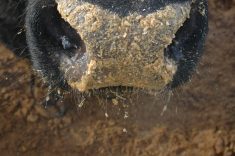Sulphate toxicity is one of the leading causes of polio encephalomalacia, which can be prevented by testing water quality
If cattle are staggering or going blind, they could suffer from polio encephalomalacia.
Dr. Steve Hendrick of the Coaldale Veterinary Clinic in Alberta said the condition is a neurological disease in ruminants that is caused by several factors, one of which is thiamine depletion.
“Polio refers to the grey matter. Encephalo means grey matter in the brain and malacia means softening. So that’s essentially what the disease is. It’s softening of the grey matter in the brain and grey matter is sort of the long extension of the nerves.
Read Also

Canadian Food Inspection Agency slammed for handling of bovine tuberculosis case
The federal government leans heavily on producers to “take one for the team” and risk their livelihoods without any reassurance of support.
“So basically, some of the neurons are being damaged or killed off, and so then you have some neurologic signs that go along with that,” he said.
Symptoms of PEM include progressive blindness, difficulty walking, depression and seizures in cattle. Hendrick said sulphate toxicity in water is one of the leading causes.
Water wells and dugouts, particularly in Saskatchewan, may have high sulphate levels, which emit the characteristic egg smell. The white alkali flats on the Prairies are high in sulphates that dry up and blow into surface waters.
“Sulphates are relatively common in water, so we see it a lot in groundwater or well water. It’s in the soil and gets leached out from runoff and ends up in sloughs and dugouts,” said Joe Harrington, water quality specialist in Lethbridge.
Producers should test their water sources, particularly during the summer pasture grazing period, when evaporation concentrates the levels of minerals. This can quickly change the levels of sulphates and convert water to a toxic level in a matter of days.
“I get a couple of dozen calls every summer on these issues. We tell them to get a water sample tested and I can help interpret the results,” said Harrington.
Livestock don’t like water that is high in sulphates and will drink from another water source unless there’s no alternative.
However, Harrington notes some cattle can tolerate varying levels of sulphates in water.
“They can kind of get used to it, so anything between 1,000 and 2,500 milligrams per litre. If the cattle are used to it, they are generally fine because every animal is a little bit different, just like humans.
“If they’re not used to it and come from good quality water and are suddenly put on something that has, let’s say 2,000 milligrams per litre, they might have problems,” he said.
Cattle also increase water consumption as temperatures rise and water quality deteriorates, which can compound the problem.
Studies have shown that as sulphate levels in water climb higher than 2,000 parts per million, cattle may show signs of the disease. Left unchecked, they will go down and often die.
If water sulphate reaches 3,000 or 4,000 parts per million, PEM is more likely.
Hendrick and Harrington advise immediately providing cattle with quality water and having them seen by a vet.
“Typically, these animals will get treated with thiamine…. Oftentimes animals with neurologic disease, we also give dexamethasone, which is a steroid that helps reduce swelling (in the brain). It’s very nonspecific, but it works quite well,” Hendrick said.
“So the sulphur inhibits some of the enzymes that the cells need to produce energy and thiamine helps counter that. That is one of its key roles, is helping to produce energy within our brain cells and neurons.”
Added Harrington: “I recommend them changing their water source right away because that’s the concern. Haul water to them if you have to, whatever it takes. Get them away from that because if you leave them on there, the week that it takes to get a water test, they might be all dead.”
Most of the time, thiamine and dexamethasone are injected into muscle. Some feeds contain thiamine but it is expensive to provide to a herd. However, that might be the best course if water quality is consistently poor.
Fortunately, PEM is relatively rare.
“I don’t see huge outbreaks anymore. Most of it is just periodic cases that pop up.
“Polio is a symptom or a syndrome where it’s a number of signs that we see. It forms a disease, but it’s not just one factor or cause. There are many causes that can present the same way and the lesions or disease that causes polio, but there’s just different ways of getting to the same outcome.”
Hendrick said PEM has the potential to severely impact the bottom line.
“When there’s an outbreak and people don’t recognize it, it could be a significant loss. I don’t think I’ve seen a death loss in a group beyond five percent. That would be high but I’m sure it could be potentially higher if it went unchecked for an extended period, if people weren’t keeping an eye,” he said.
“But it’s pretty simple. Do a water test to figure out is this a potential risk or issue.
“It’s not like this is the number one disease that all producers are struggling with…. The sad thing is it’s one of those things that we can actually manage. If you test your water, you can identify that issue, and then you can put strategies in place to avoid or fix that.”
















